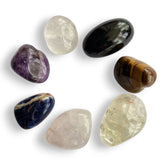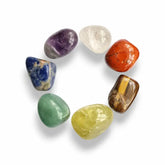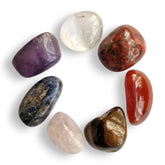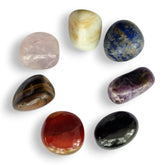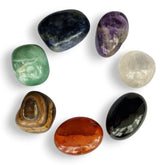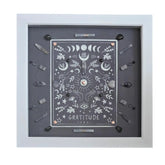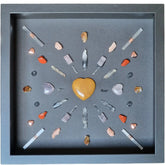The Mystical Beauty of Amethyst: History, Benefits, and Uses
Amethyst is purple quartz linked with calm, clarity and protection. Many people use it for meditation, better sleep and emotional balance. Keep a cluster by your bed, wear a pendant during the day or meditate with a palm stone, then cleanse it monthly with water, smoke or moonlight.
Amethyst Stone Benefits, Meaning & Healing Uses
Amethyst, the beautiful purple quartz, is one of the most cherished healing crystals in the world. Known for its calming energy and deep spiritual meaning, this stone has been valued for centuries for its healing benefits, protective properties and inspiring beauty. In this guide, discover the amethyst crystal benefits for mind, body and spirit, its fascinating history and how to use it in modern life.
The Origins and History of Amethyst

Amethyst, with its captivating purple hue, stands as one of the most beloved and revered semiprecious stones in the world. Its vibrant color, ranging from delicate lilac to deep violet, makes it a favorite in jewelry and gives it an air of mystery and spirituality. Amethyst has long been associated with calming and healing energies that promote peace, clarity and emotional balance.
For centuries, people across many cultures have turned to amethyst for both its beauty and its metaphysical properties. In ancient times it was cherished for protective qualities, with legends about its ability to prevent intoxication and guard against negative influences. Today amethyst remains significant, embraced for soothing energy in meditation, spiritual healing and as a symbol of inner strength.
In modern times, amethyst has found a place in many contexts, from statement pieces in fine jewelry to crystals used in energy work and feng shui practices. Whether it adorned the fingers of royalty in the past or acts as a tool for personal growth in the present, amethyst continues to captivate and inspire. This fascination reflects both its striking appearance and the deep spiritual connection many feel when working with this ancient stone.
Ancient Significance
The name “amethyst” comes from the Greek word amethystos, which translates to “not intoxicated”. In ancient Greece people believed that wearing or drinking from amethyst could prevent drunkenness and promote mental clarity. Greek mythology tells that the purple hue came from the god Dionysus who poured wine over clear quartz. The Greeks and Romans used amethyst in carved gems and jewelry as a symbol of wisdom and sobriety.
In ancient Egypt amethyst was carved into protective amulets and talismans believed to guard against harmful energies and thoughts. The stone was favored for its perceived ability to ward off negative emotions and even disease. In ancient Rome amethyst adorned crowns and rings, thought to bring courage and victory in battle.
Its allure was also linked with royalty and power, making it a popular choice for crowns, scepters and jewelry of kings and queens. Across history amethyst has been tied to divine protection and strength, a connection that still resonates today.
Cultural Significance Across the World
Amethyst’s cultural influence spans many religious and spiritual contexts.
In Christianity amethyst became a symbol of piety and celibacy. The stone often appeared in rings worn by bishops and high clergy, symbolizing spiritual wisdom and humility. Its purple color was seen as a representation of Christ’s suffering and triumph over worldly temptations. During the Middle Ages amethyst ranked among Cardinal Gemstones alongside sapphire, ruby and emerald.
In Buddhism amethyst is revered as a stone for meditation and spiritual growth. Monks have long used amethyst prayer beads to focus the mind during deep meditation, encouraging insight and inner peace.
Among Native American tribes amethyst appeared in ceremonies and healing practices. Shamans and healers used the stone to soothe the mind and bring peace, and it was believed to connect people with spiritual guides and ancestors.
The Physical Properties of Amethyst
Geological Formation
Amethyst is a variety of quartz, one of the most abundant minerals on Earth. Chemically it shares the same structure as clear quartz, silicon dioxide (SiO2). Its striking purple color can range from light lavender to deep violet and is due to trace amounts of iron impurities that, when exposed to natural irradiation, create distinctive purple tones.
Amethyst forms in volcanic rocks. Cavities in lava known as geodes allow silica rich fluids to crystallize over millions of years. As the fluids cool they trap iron impurities, and natural radiation from surrounding rock alters the iron oxidation state, producing purple shades.

Significant deposits come from Brazil, Zambia, Uruguay, Russia and the United States. Each region yields distinct qualities:
- Brazil produces large geodes with deep purple hues.
- Zambia often yields stones with a rich bluish tint.
- Uruguay is known for deeply saturated crystals in smaller geodes.
- Russia, especially the Ural Mountains, historically produced high quality deep purple material.
- United States sources such as Arizona and North Carolina tend to have lighter tones.
Varieties of Amethyst
Amethyst color varies widely and is often grouped by tone and intensity, from light lavender to dark purple.
- Light and dark purple. Lavender amethyst has a delicate lilac color and a soothing feel. Dark purple material is considered most valuable when color zoning is minimal.
- Ametrine. This rare variety combines amethyst and citrine in one crystal. Specific conditions heat part of the crystal to yellow while the rest remains purple, creating a striking blend of qualities.
- Lavender amethyst. Pale violet stones are prized for gentle beauty and meditative calm.
- Siberian quality. Deep purple with flashes of red and blue is often called Siberian quality. Although original Russian sources have dwindled, similar material appears in Zambia and Brazil.
Metaphysical Properties and Healing Benefits
Spiritual Significance
Amethyst is known as a stone of spirituality and protection that supports a deep connection to higher consciousness. Many believe it activates the crown chakra at the top of the head which is associated with spirituality, enlightenment and higher wisdom. People use amethyst to create inner peace, to deepen meditation and to enhance intuition while shielding against negative energy.
Healing and Emotional Benefits
Amethyst is widely associated with calming the mind and reducing stress. Many people use it in times of emotional upheaval to encourage balance and quiet overactive thoughts. It is often used alongside practices that address anger, fear and anxiety, replacing tension with a sense of calm.
Amethyst is also used for sleep. Placing a stone under the pillow or on a bedside table is said to encourage restful sleep and protect against negative energy at night.
The historic link with sobriety appears in modern use as well. People sometimes choose amethyst as a supportive tool while working to release addictive habits because its symbolism speaks to strength, self control and clear thinking.
Physical Healing Properties
In alternative wellness traditions amethyst is linked with overall balance. It is sometimes used with intentions related to the immune system, hormone balance and skin health. Some people place the stone on areas of tension to ease headaches or stress related discomfort.
Disclaimer. Crystal benefits are based on traditional beliefs and personal experiences. They are not medically proven and do not replace professional care.
Discover more healing crystals here.
Uses of Amethyst in Modern Practices
In Jewelry
Amethyst remains a favorite in modern jewelry for both beauty and meaning. The rich purple hue ranges from delicate pastels to deep violet and suits rings, necklaces, earrings and bracelets. It takes many cuts, from brilliant facets to smooth cabochons, and pairs well with gold or silver settings.
Explore our selection of amethyst jewelry for everyday wear or special gifts.
In Feng Shui and Interior Design

Amethyst’s calming reputation makes it popular in feng shui and interior design. Clusters and geodes are used to cleanse the energy of a space and to encourage harmony and focus. Place a cluster in the living room or bedroom for a tranquil feel, or near the entrance to set a welcoming tone.
In office spaces a small cluster on a desk can serve as a reminder to pause, breathe and refocus during the day.
Meditation and Spiritual Practices
For meditation hold a point or palm stone, breathe slowly for a few minutes and set a simple intention such as clarity or calm. Amethyst also works well in crystal grids designed to amplify intentions. Many people wear amethyst to protect their energy during practice or keep a stone by the bed for lucid dreaming.
Caring for Your Amethyst
Cleansing and Recharging
Cleanse and recharge amethyst regularly. Gentle options include moonlight on a windowsill, passing the stone through cleansing smoke or a brief rinse in lukewarm water followed by careful drying. Avoid long exposure to direct sunlight because color may fade over time.
Storing and Polishing
Amethyst ranks 7 on the Mohs scale, which suits daily jewelry, yet it can still be scratched by harder materials. Store jewelry in a soft pouch or a separate compartment away from other stones. For geodes and clusters choose a stable surface in a low traffic area.
For routine care wipe gently with a soft cloth. For deeper cleaning use mild soapy water and a soft brush, then dry thoroughly.
Amethyst in Astrology and Birthstones
Zodiac Connections
Amethyst has deep ties to Pisces and Aquarius. For Pisces it is associated with emotional balance, creativity and intuition. For Aquarius it supports mental clarity and a calm, open mindset. In both cases the stone symbolizes a bridge between clear thinking and compassionate insight.
Birthstone for February
Amethyst is the official birthstone for February and is often linked with wisdom, protection and spiritual awareness. The tradition reaches back to classical times where it was associated with clear thinking and inner peace. For February birthdays it makes a meaningful gift with both beauty and symbolism.
Explore zodiac sets for Pisces and Aquarius.
Conclusion
Amethyst blends elegance with meaning and continues to inspire people around the world. From ancient myths and royal adornment to meditation cushions and nightstands, it offers a calm and clarifying presence. Whether you love its beauty or connect with its symbolism, amethyst can enrich daily life and spiritual practice.
Ready to explore natural clusters, palm stones and jewelry that align with your intentions? Shop our curated Amethyst Collection.
Amethyst FAQ
Which chakra is amethyst linked with? It is commonly associated with the crown chakra where it supports clarity and spiritual connection.
Can amethyst help with sleep? Many people keep a stone by the bed for a calming atmosphere, although results vary and evidence is anecdotal.
How do I cleanse amethyst safely? Use a brief water rinse, cleansing smoke, moonlight or sound. Avoid long sun exposure.
Is deeper purple better? Color preference is personal. Deep purple stones are prized, while lighter lavender has a gentle, soothing feel.
Can I shower with amethyst jewelry? Remove jewelry before showering to avoid residue and potential scratches.
Important Disclaimer Information
The use of crystals for healing, crystal healing bracelets, necklaces and other crystal jewelry is based on traditional beliefs and is not scientifically proven. While many people have reported positive experiences with crystals, their effectiveness may vary from person to person. It is important to always seek the advice of a qualified healthcare professional before using crystals or any other complementary therapy.
Crystals should not be used as a substitute for professional medical care. Additionally, the use of crystal healing jewelry should never interfere with any prescribed medication or medical treatment.


